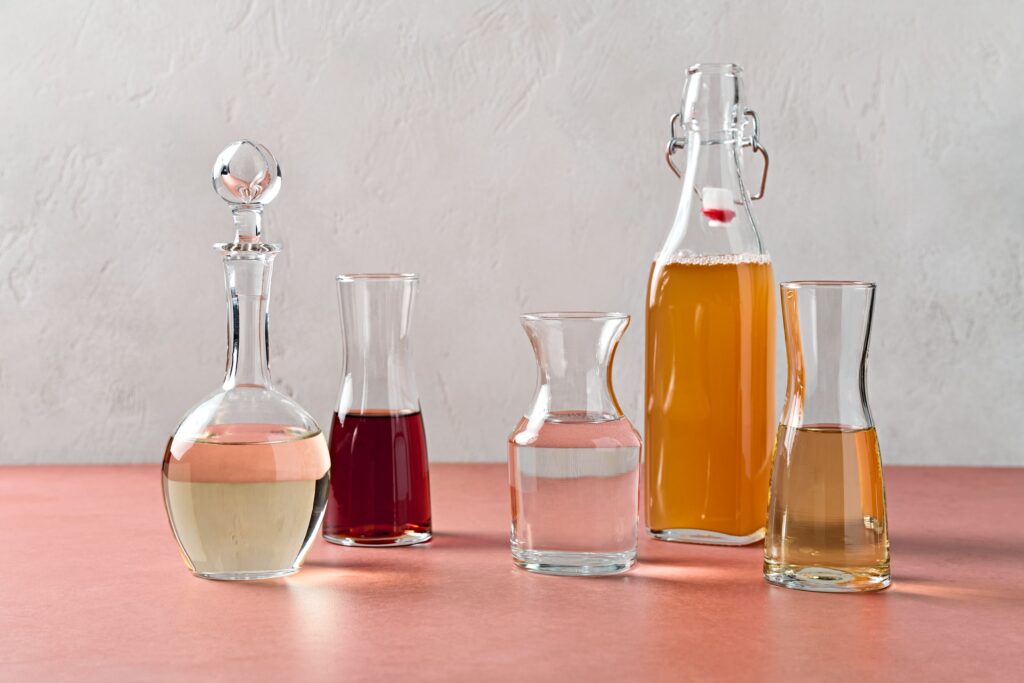Rice vinegar and white vinegar are distinct types of vinegar with unique characteristics. Rice vinegar, derived from fermented rice or rice wine, offers a mild, slightly sweet flavor profile, often used in Asian cuisine like sushi rice, pickles, and dressings. It has lower acidity and comes in various varieties, including seasoned and unseasoned types. On the other hand, white vinegar, made from fermented grain alcohol, boasts a sharp, sour taste with high acidity.
It is colorless and finds widespread use in pickling, preserving, cleaning, and certain baking recipes. While rice vinegar is milder and sweeter, white vinegar is more acidic and versatile. Their culinary applications differ significantly, but both can occasionally substitute for one another, though the unique flavors and acidity levels may influence the final taste of the dish.
How is Rice Vinegar Made and What Sets Its Characteristics Apart?

Rice vinegar is a type of vinegar made from fermented rice. The process of making rice vinegar involves several steps:
Fermentation
Rice vinegar is typically made by fermenting rice, where the starches in the rice are converted into sugars and then alcohol by the action of yeasts. This fermentation process is similar to that used in making rice wine.
Acidification
After the alcohol is produced through fermentation, bacteria known as acetic acid bacteria (Acetobacter) further ferment the alcohol into acetic acid. This acidification process creates vinegar.
There are a few different methods to make rice vinegar, resulting in variations in taste, color, and aroma. The two primary traditional methods are:
Slow fermentation
This method involves allowing the fermentation process to occur naturally over a longer period, resulting in a milder and slightly sweet flavor profile. It often produces a higher quality vinegar but takes more time.
Quick fermentation
This method involves speeding up the fermentation process using additional ingredients like koji (a fungus used in fermentation) or added acids. This results in a faster production but might yield a sharper or more acidic taste compared to slow fermentation.
Characteristics that set rice vinegar apart include
Mild Flavor
Rice vinegar generally has a mild and slightly sweet flavor compared to other types of vinegar like white vinegar or apple cider vinegar.
Color
It tends to be clear or light yellow in color. The color can vary depending on the specific type of rice used and the fermentation process.
Acidity
Rice vinegar typically has lower acidity compared to other vinegars, making it a preferred choice in certain recipes, especially in Asian cuisine.
Aroma
It has a delicate aroma that’s less pungent than some other types of vinegar, which makes it suitable for various culinary applications.
Versatility
Rice vinegar is commonly used in Asian dishes such as sushi rice, salad dressings, pickles, marinades, and sauces. Its mild flavor allows it to complement various ingredients without overpowering them.
What Defines White Vinegar and How Does It Differ from Rice Vinegar?

White vinegar, also known as distilled vinegar, is a type of vinegar made through the fermentation of distilled alcohol. Here are some defining characteristics of white vinegar and how it differs from rice vinegar:
Raw Material
White Vinegar
It is typically made from grains like corn, barley, or wheat. The fermentation process starts with these grains, which are converted into alcohol before undergoing a second fermentation to produce vinegar.
Rice Vinegar
As mentioned earlier, rice vinegar is made from fermented rice. The fermentation process involves converting the starches in rice into sugars and then alcohol, followed by the conversion of alcohol into vinegar.
Color and Clarity
- White Vinegar: It is clear and colorless, giving it a transparent appearance.
- Rice Vinegar: Rice vinegar can vary in color, but it’s usually clear or light yellow. It might have a slightly cloudy appearance due to residual rice solids or other fermentation byproducts.
Taste and Acidity
- White Vinegar: White vinegar has a very sharp, acidic taste. It tends to be stronger and more intense in flavor compared to rice vinegar.
- Rice Vinegar: Rice vinegar has a milder taste and is slightly sweet, with a lower acidity compared to white vinegar. It has a more delicate flavor profile that doesn’t overpower dishes.
Culinary Uses
- White Vinegar: Due to its strong taste and high acidity, white vinegar is commonly used in pickling, preserving foods, cleaning, and as a household cleaner due to its disinfectant properties.
- Rice Vinegar: Rice vinegar is a staple in Asian cuisine and is used in various dishes such as sushi rice, salads, marinades, stir-fries, sauces, and dressings. Its mild flavor and lower acidity make it a versatile ingredient in cooking.
Production Process
- White Vinegar: The production of white vinegar involves the fermentation of distilled alcohol, which is then oxidized into acetic acid.
- Rice Vinegar: The production of rice vinegar involves fermenting rice and then allowing the fermentation process to convert the rice starches into sugars, alcohol, and finally, acetic acid.
FAQ’s
Can you use white vinegar on rice?
White vinegar is not commonly used for flavoring rice due to its strong taste and high acidity, which may overpower the dish. Rice vinegar or other milder vinegars are preferred for rice seasoning.
Is rice vinegar acidic?
Yes, rice vinegar is acidic, but it typically has lower acidity compared to other types of vinegar, like white vinegar. Its milder acidity contributes to its subtle flavor in cooking.
Which vinegar is best for cooking?
The choice of vinegar for cooking depends on the recipe. Rice vinegar is excellent for Asian dishes, while apple cider vinegar or red wine vinegar might be preferred in Western cuisines.
What is rice vinegar used for?
Rice vinegar is commonly used in various culinary applications, especially in Asian cuisine. It’s used in making sushi rice, salad dressings, marinades, sauces, pickles, and more.
When should you use rice vinegar?
Rice vinegar is best used when a mild, slightly sweet vinegar flavor is desired. It’s suitable for enhancing the taste of salads, sushi, stir-fries, marinades, and dressings.
What is the secret to fluffy rice?
The key to achieving fluffy rice involves rinsing the rice thoroughly before cooking to remove excess starch, using the correct water-to-rice ratio, and allowing it to steam undisturbed after cooking to ensure proper fluffiness.
Final Words
In conclusion, rice vinegar, derived from fermented rice, undergoes a meticulous process involving fermentation and acidification by acetic acid bacteria. This vinegar stands out due to its distinct characteristics, which vary based on the method of production. Slow fermentation yields a milder, slightly sweet flavor, while quick fermentation results in a sharper taste.
Its mild flavor, clear or light yellow color, lower acidity, delicate aroma, and versatility distinguish rice vinegar. Commonly used in Asian cuisine, it perfectly complements a wide array of dishes, including sushi rice, salads, marinades, and sauces, without overpowering their flavors.

